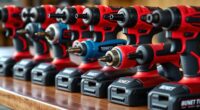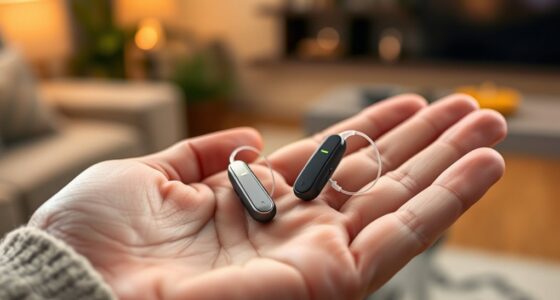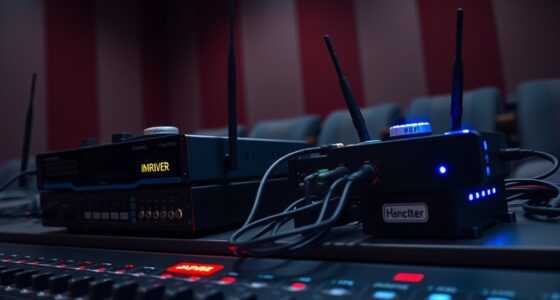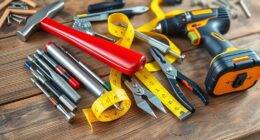A neckloop is a simple device that connects your T-coil hearing aids to audio sources wirelessly, usually via magnetic induction or Bluetooth. It boosts sound clarity and reduces static, making conversations, TV, or calls easier, especially in noisy environments. Choosing the right type—over-the-ear or discreet in-canal—depends on your needs. Proper setup and troubleshooting can improve your experience. Keep exploring to discover how to get the most out of your neckloop.
Key Takeaways
- Neckloops connect hearing aids with T-coils to audio sources wirelessly via magnetic induction.
- They improve sound clarity and reduce interference, especially in noisy environments like TV watching or public spaces.
- Compatibility varies; choose between analog or digital models based on device inputs and personal preferences.
- Proper positioning and adjustments ensure optimal sound transmission and minimize static or dropout issues.
- Wireless neckloops and weather-resistant options enhance outdoor use and convenience for different listening environments.
What Is a Neckloop and How Does It Work?
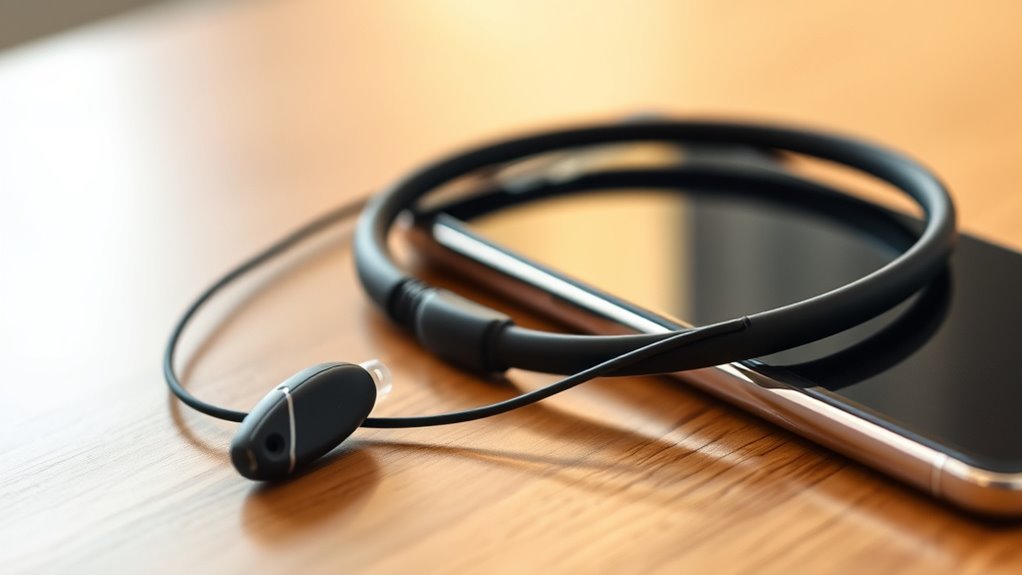
A neckloop is a small device that helps connect your hearing aids or cochlear implants to audio sources like phones, TVs, or music players. It works by transmitting sound wirelessly through magnetic induction, allowing clear audio delivery directly to your T-coil-equipped hearing devices. While traditional neckloops rely on magnetic signals, wireless alternatives like Bluetooth adapters are also available, offering more versatile connectivity options. These wireless options can work with a variety of devices and often provide a seamless experience with minimal setup. Headset compatibility is important because some neckloops are designed to work specifically with T-coil hearing aids, ensuring you get the best sound quality. Whether wired or wireless, a neckloop simplifies listening and enhances your audio experience. Additionally, understanding the effectiveness of neckloops can help users optimize their listening experience.
Benefits of Using a Neckloop With Your Hearing Aids
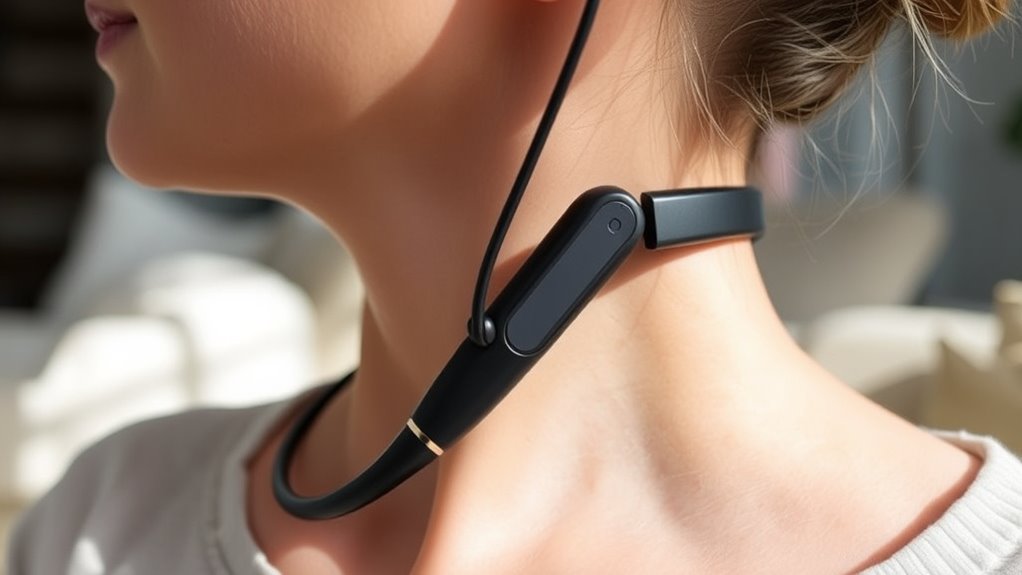
Using a neckloop with your hearing aids offers several clear advantages, making it easier to enjoy clear, direct sound from your favorite devices. Unlike wireless alternatives that may require pairing or app setup, a neckloop provides a simple, reliable connection to T-coil-equipped hearing aids, reducing interference and static. It’s especially helpful in noisy environments or when listening to TVs, as it delivers sound directly into your ears. Keep in mind, though, that some neckloops rely on batteries, so you’ll want to contemplate battery life and replacements when choosing a model. Overall, using a neckloop enhances your listening experience by offering a straightforward, effective way to connect without the hassle of wireless setup or concerns about compatibility. Incorporating the right accessories can also complement your overall farmhouse bedroom design, creating a cozy environment that promotes relaxation and comfort.
Different Types of Neckloops and Which One Is Right for You

Choosing the right neckloop depends on your preferences and needs. You’ll want to contemplate options like over-the-ear versus in-canal designs, as well as analog versus digital models. Understanding compatibility and connectivity will help you find the best fit for your hearing aids and lifestyle. Additionally, considering holistic approaches to wellness can enhance overall satisfaction with your selection.
Over-the-Ear vs. In-Canal
When deciding between over-the-ear and in-canal neckloops, it’s important to contemplate how each type fits your lifestyle and preferences. Over-the-ear neckloops tend to be bulkier but offer better power and easier adjustments, making them suitable for active users. In-canal options are more discreet and comfortable, especially if you prefer a low-profile look or wear headphones regularly. If you’re interested in wireless alternatives, both types can support Bluetooth connections, but over-the-ear models often provide more robust compatibility. Fashion considerations also play a role—if you want a subtle, less noticeable device, in-canal neckloops are ideal. Additionally, understanding the types of neckloops can help you make an informed choice that suits your specific needs. Ultimately, choose the style that aligns with your daily routine, comfort, and aesthetic preferences to enhance your sound experience seamlessly.
Analog vs. Digital Neckloops
Digital neckloops often deliver clearer sound quality and more advanced features, making them a popular choice for tech-savvy users. They typically provide better sound quality and offer wireless alternatives, reducing cable clutter. Digital models convert the audio signal into a digital format, which minimizes interference and enhances clarity. If you prioritize crisp sound and seamless connectivity, a digital neckloop is likely your best option. On the other hand, analog neckloops are simpler, usually more affordable, and rely on traditional magnetic induction. While they may have slightly lower sound quality and are susceptible to interference, they’re still reliable for basic needs. Consider your environment and preferences when choosing: digital offers superior sound quality and wireless options, while analog remains straightforward and budget-friendly. Additionally, understanding the role of high-quality audio in enhancing hearing device performance can help you select the most suitable neckloop type.
Compatibility and Connectivity
Understanding the compatibility and connectivity options of neckloops is essential to guarantee they work seamlessly with your audio devices. Different types of neckloops offer various connection methods, so you need to take into account your device’s compatibility. Traditional analog neckloops connect via standard audio jacks, making them simple and reliable. Digital neckloops, on the other hand, may require specific inputs or wireless alternatives like Bluetooth, which can expand your options. If your device lacks a T-coil or audio jack, look for models with wireless connectivity to ensure compatibility. Some neckloops are designed specifically for certain brands or devices, so verify compatibility before purchasing. Choosing the right neckloop depends on your device’s input options and whether you prefer wired or wireless solutions for convenience and flexibility.
How to Properly Use and Adjust Your Neckloop

To get the best sound quality and comfort from your neckloop, you need to properly use and adjust it. Start by positioning the loop comfortably around your neck, ensuring the coil is centered over your hearing aid’s T-coil. Adjust the length so it’s snug but not tight. This ensures clear sound transmission and reduces noise. For ideal performance, consider wireless alternatives if you experience interference or discomfort. Regular maintenance tips include cleaning the coil and checking connections. Use the table below to help you fine-tune your neckloop settings:
| Adjustment Step | What to Do | Why It Matters |
|---|---|---|
| Positioning | Center the coil over T-coil | Clearer sound, less feedback |
| Tightness | Keep snug but comfortable | Prevent slipping, improve sound |
| Cable/Connector Check | Ensure secure attachment | Avoid static or dropout |
Proper use and adjustment maximize sound clarity and comfort. Additionally, being aware of sound quality and how it can be affected helps ensure optimal listening experiences.
Tips for Troubleshooting Common Neckloop Issues
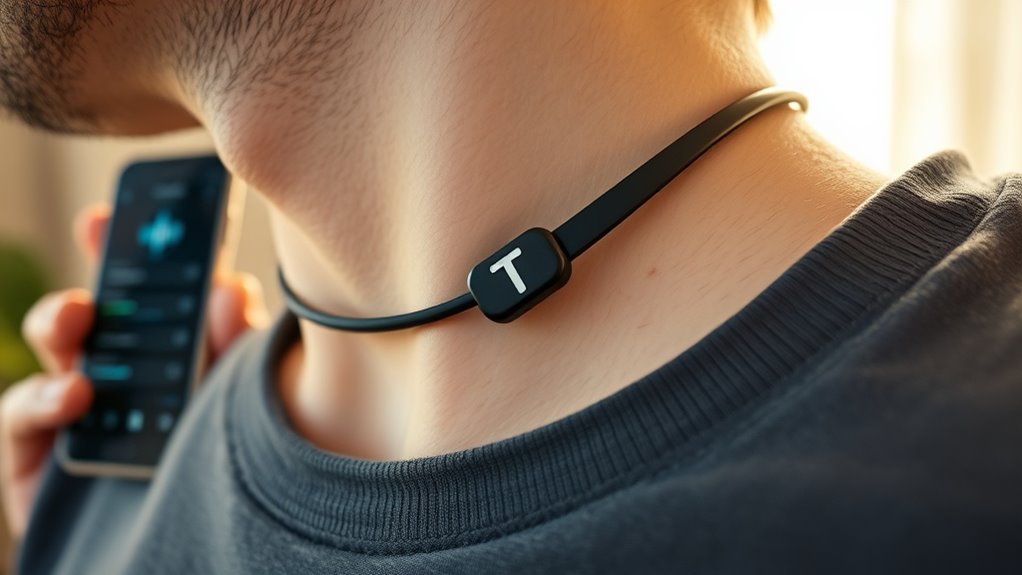
Even with proper use and adjustments, you might still encounter issues with your neckloop. Wireless technology can sometimes cause interference or connectivity problems, so guarantee your device and neckloop are within range and free from obstructions. Check your user maintenance routines—clean the cord and connectors regularly to prevent dirt or corrosion from disrupting sound quality. If you experience weak or inconsistent sound, verify that your T-coil settings are correct and that the neckloop is securely connected to your device. Resetting your equipment or turning it off and on again can resolve minor glitches. Also, consider testing with different devices or batteries to isolate the problem. Staying proactive with user maintenance and understanding wireless technology fundamentals can help you troubleshoot and maintain peak sound performance. Understanding sound quality is essential to ensuring your setup functions optimally.
Enhancing Your Listening Experience in Various Settings
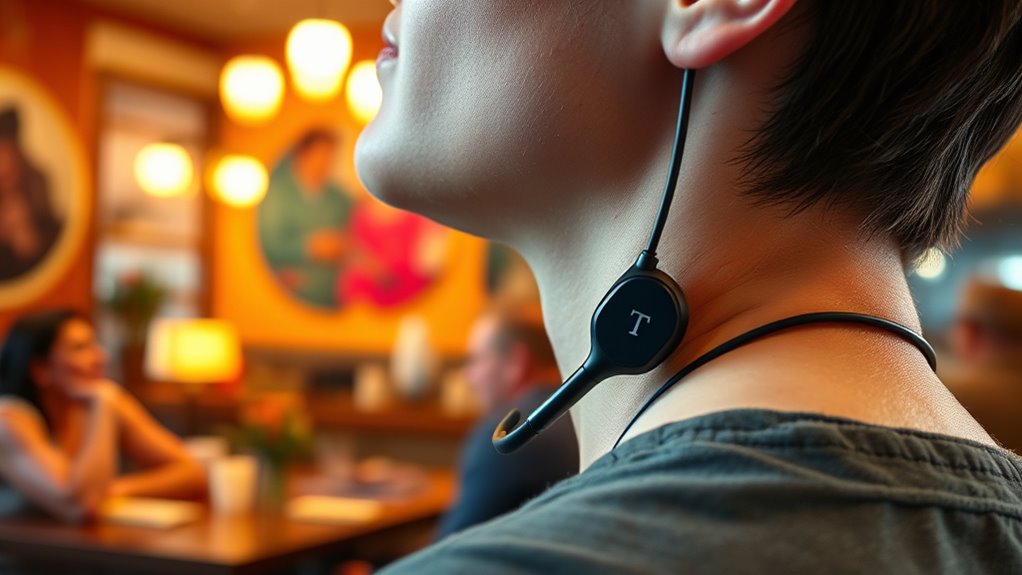
Adapting your neckloop setup to various environments can substantially improve your listening experience. In noisy places like cafes or crowded events, consider using wireless alternatives such as Bluetooth neckloops or FM systems for clearer sound and greater freedom of movement. When choosing accessories, keep fashion considerations in mind; sleek, discreet designs blend better with your style and won’t draw unwanted attention. For outdoor settings, verify your neckloop is compatible with weather-resistant devices or use a portable amplifier for better sound clarity. Adjust the length of your cord or choose wireless options to prevent tangling. Incorporating personal growth strategies such as mindfulness can further enhance your listening experience by reducing distractions and increasing focus. By tailoring your setup to different environments and considering fashion, you’ll enjoy more consistent, comfortable listening that adapts seamlessly to your lifestyle.
Frequently Asked Questions
Can I Use a Neckloop if I Don’T Wear Hearing Aids?
You might wonder if you can use a neckloop without hearing aids. While neckloops are primarily designed for T-coil compatibility in hearing aids, some models work with cochlear implants or standalone T-coil devices. If you don’t have hearing aids, explore alternative hearing solutions like dedicated T-coil receivers or assistive listening devices. Always verify the neckloop’s compatibility to confirm it suits your needs and provides the best sound quality.
Are Neckloops Compatible With All T-Coil Equipped Devices?
You might wonder if neckloops work with all T-coil equipped devices. Compatibility depends on the device’s design and signal strength; most modern T-coil systems are compatible with neckloops, but some older or specialized devices may not be. To guarantee proper function, check the device’s specifications and test the signal quality. If compatibility issues arise, consider consulting an audiologist for personalized advice and possible solutions.
How Long Does a Typical Neckloop Battery Last?
A typical neckloop’s battery lasts like a gentle breeze, around 8 to 12 hours, depending on its battery efficiency and power consumption. If you use it continuously, expect to recharge or replace the battery daily. Factors like volume settings and device age affect longevity. To get the most out of your neckloop, choose models with efficient power management, ensuring reliable sound support without frequent interruptions.
Is There a Difference in Sound Quality Between Wireless and Wired Neckloops?
When comparing wireless vs wired neckloops, you might notice differences in sound clarity. Wired neckloops often provide more consistent, interference-free sound, ensuring better clarity. Wireless versions offer convenience and freedom of movement but can sometimes introduce background noise or lag, affecting sound quality. Your choice depends on your environment and priorities, but generally, wired neckloops deliver more reliable sound clarity, especially in noisy settings.
Can Neckloops Be Used Outdoors in Windy or Noisy Environments?
Think of using a neckloop outdoors as trying to hear a whisper in a storm. Wind noise can easily drown out the signal, reducing clarity. While you can use neckloops outside, expect some challenges with sound quality. To improve signal clarity, choose a sheltered spot or use windshields designed for microphones. Remember, the environment plays a vital role in how well your neckloop performs in windy or noisy settings.
Conclusion
A neckloop transforms your hearing experience, turning static into clarity and silence into connection. Like a bridge spanning noisy crowds or quiet rooms, it brings sound closer and clearer. Instead of missing out on conversations, you’re immersed in every word. With the right neckloop and proper use, you’ll see the world in a new light—where sounds are not just heard, but felt. Embrace this simple device and open the door to richer, more vibrant listening.


